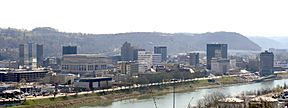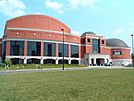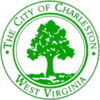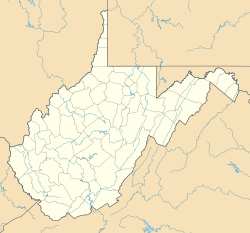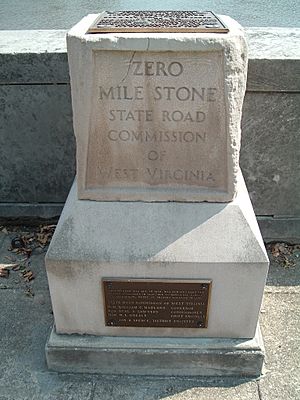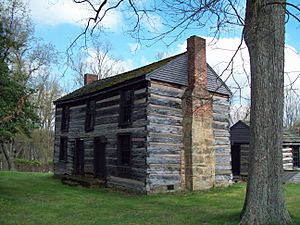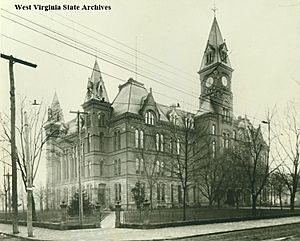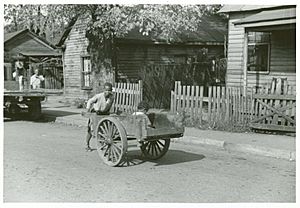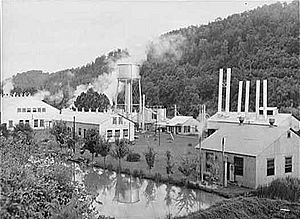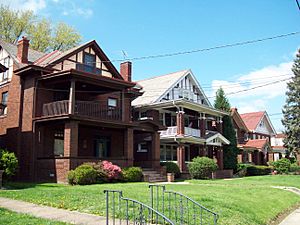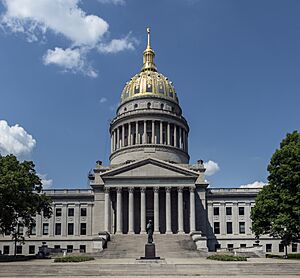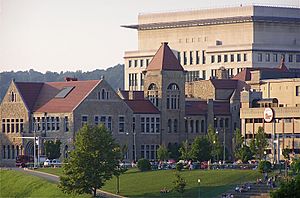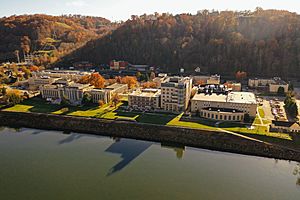Charleston, West Virginia facts for kids
Quick facts for kids
Charleston
|
|||
|---|---|---|---|
|
Downtown Charleston
West Virginia State Museum
Capitol Market
Kanawha County Courthouse
|
|||
|
|||
| Nickname(s):
Charlie West
|
|||
| Country | United States | ||
| State | West Virginia | ||
| County | Kanawha | ||
| Founded | 1788 | ||
| Incorporated | 1794 | ||
| Government | |||
| • Type | Strong-Mayor Government | ||
| Area | |||
| • City | 32.535 sq mi (84.265 km2) | ||
| • Land | 31.397 sq mi (81.317 km2) | ||
| • Water | 1.138 sq mi (2.948 km2) | ||
| Elevation | 597 ft (182 m) | ||
| Population
(2020)
|
|||
| • City | 48,864 | ||
| • Estimate
(2023)
|
46,838 | ||
| • Rank | US: 863rd WV: 1st |
||
| • Density | 1,491.83/sq mi (575.99/km2) | ||
| • Urban | 140,958 (US: 248th) | ||
| • Metro | 203,164 (US: 228th) | ||
| Time zone | UTC−5 (Eastern (EST)) | ||
| • Summer (DST) | UTC−4 (EDT) | ||
| ZIP Codes |
ZIP Codes
|
||
| Area code(s) | 304 and 681 | ||
| FIPS code | 54-14600 | ||
| GNIS feature ID | 1558347 | ||
| Highways | US-60, I-64, I-77, US-119, and SR-214 | ||
| Sales tax | 7.0% | ||
Charleston is the capital city of West Virginia. It is also the largest city in the state. Charleston is located where the Elk River and Kanawha River meet. In 2020, about 48,864 people lived there. The larger Charleston area has over 200,000 residents.
The first permanent settlement in the Kanawha Valley was Fort Morris, built in 1773 by William Morris. The town of Charleston was officially started in 1794. Early industries that helped Charleston grow included making salt and finding natural gas. Later, coal became very important for the city's economy. Today, Charleston's economy relies on trade, government jobs, healthcare, and education.
Charleston is home to a baseball team called the Charleston Dirty Birds. It also hosts the yearly Charleston Distance Run. You can find Yeager Airport and the University of Charleston in the city. Other universities like West Virginia State University, West Virginia University, and Marshall University also have campuses nearby.
Contents
History of Charleston
How Charleston Started
After the American Revolutionary War, people began to move into western Virginia. Charleston became an important place because of its many natural resources. It is now the capital and largest city of West Virginia.
Charleston's history began in the 1700s. In 1773, Thomas Bullitt received a large piece of land near the mouth of the Elk River. This land was later sold to Colonel George Clendenin in 1786. Clendenin and his group of Virginia Rangers built the first permanent settlement, Fort Lee, in 1787. This fort was located where Brooks Street and Kanawha Boulevard are today. Many believe Charleston is named after Clendenin's father, Charles. In 1794, the Virginia General Assembly officially created Charlestown. At that time, only 35 people lived in seven houses in the town.
Charleston is part of Kanawha County. The name "Kanawha" comes from an old Native American word meaning "water way" or "Canoe Way." This refers to the river that flows through Charleston. The first building in the county was a two-story jail.
In 1791, Daniel Boone, a famous pioneer, was elected to serve in the Virginia House of Delegates. He represented Kanawha County.
Growing in the 1800s
In the early 1800s, people found salt underground along the Kanawha River. The first salt well was drilled in 1806. This discovery helped the area's economy grow a lot. By 1808, a lot of salt was being made every day. An area next to Charleston, called Kanawha Salines (now Malden), became the world's top salt producer. To get the salt, people heated salty water until the water evaporated, leaving salt crystals. Many people were forced to work in these salt operations. In 1818, the Kanawha Salt Company, the first trust in the United States, started operating. In the same year, "Charlestown" was shortened to "Charleston." This was done to avoid confusion with another Charles Town in eastern West Virginia.
Captain James Wilson found the first natural gas well in 1815 while drilling for salt. This was near where the state capitol is today. In 1817, coal was discovered. Coal slowly began to be used to fuel the salt works. The salt industry became less important after 1861. However, during World War I, there was a high demand for chemicals that could be made from salt.
The town kept growing until the American Civil War started in 1861. Virginia left the Union. But Charleston and much of western Virginia were divided. Some people supported the Union, and others supported the Confederacy. On September 13, 1862, Union and Confederate armies fought in the Battle of Charleston. The Confederates won, but Union soldiers returned six weeks later and took back the city. Charleston stayed under Union control for the rest of the war.
The North wanted to separate West Virginia from the rest of Virginia. This was partly because industries in the North needed coal from western Virginia. Federal troops captured mines and transportation routes early in the war. In 1863, West Virginia became the 35th state.
Choosing the state capital was hard. For several years, the capital moved between Wheeling and Charleston. In 1877, people voted for a permanent location. Charleston won the vote. Eight years later, the state capitol opened in Charleston.
Many new organizations and schools were started in Charleston during this time. The West Virginia Historical and Antiquarian Society was formed in 1890. The West Virginia Colored Institute, now West Virginia State University, was established in 1891.
Charleston in the 1900s
Charleston became the center of state government. Natural resources like coal and natural gas, along with new railroads, helped the city grow. New industries like chemical, glass, and steel companies moved to the state because of these resources. The city started a chamber of commerce in 1900. Many new buildings were constructed in Charleston during this time. Some of these buildings, including churches and offices, are still in downtown Charleston. The State Bureau of Archives and History was created in 1905. The Charleston Public Library opened in 1909.
The city's first chemical factory started in 1913. Later, large glass factories like Libbey-Owens-Ford and Owens Bottle Company opened. Charleston City Hall was built in 1921. In the same year, a fire destroyed the capitol building. A new one was quickly built, but it also burned down in 1927. The current West Virginia State Capitol was designed by architect Cass Gilbert. It was finished in 1932 and cost almost $10 million.
Charleston Municipal Airport opened in 1909. In 1934, the city library grew into the Kanawha County Public Library system. Morris Harvey College moved to Charleston in 1935.
The Charleston Municipal Auditorium was completed in 1939. During World War II, a large plant opened nearby in Institute. It made synthetic rubber for the war effort. After the war, Charleston saw more big construction projects. Kanawha Airport (now Yeager Airport) was built in 1947. This project involved clearing three mountaintops. Kanawha Boulevard, a four-lane road along the river, was also built in the early 1940s. The Charleston Civic Center opened in 1959.
In the 1960s, Charleston became a hub for the Interstate Highway System. Three major interstates—I-64, I-77, and I-79—all meet in Charleston. In 1961, the Kanawha River flooded parts of the city. In 1973, Morris Harvey College changed its name to the University of Charleston.
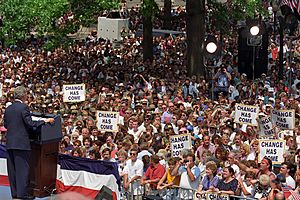
The Charleston Town Center mall opened in 1983. It was the largest downtown mall east of the Mississippi River at the time. Downtown Charleston began to be revitalized in the late 1980s. Streets like Capitol and Quarrier got new building fronts, trees, and brick walkways. Also in 1983, West Virginia Public Radio started a live music show called Mountain Stage. This show became popular across the country and around the world.
New developments in the 1990s included the Robert C. Byrd Federal Building and Haddad Riverfront Park. Charleston launched its city website in 1998.
Charleston in the 2000s
In 2003, the Clay Center for the Arts & Sciences opened. This center has a performance hall, a theater, a discovery museum, and an art museum. It also has the ElectricSky Theater, which is a planetarium and dome-screen cinema. The West Virginia Music Hall of Fame was established in 2005.
Many festivals and events are held in Charleston each year. These include Multifest, Vandalia Festival, and a July 4th celebration with fireworks. The Sternwheel Regatta, which started in 1970, was brought back in 2022. It features carnival rides and live music. In 2005, FestivALL Charleston began. It is a ten-day festival with music, dance, theater, and art.
The Charleston Area Alliance works to help the city's economy grow and improve downtown. Charleston Main Streets also helps business areas in the East End and West Side neighborhoods.
Where is Charleston?
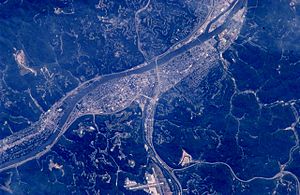
Charleston is located in west-central Kanawha County. It is about 597 feet (182 m) above sea level. The city is where Interstates 79, 77, and 64 meet. It is also where the Kanawha and Elk rivers come together.
The city covers about 32.535 square miles (84.27 km2). Most of this area is land, with a small part being water.
Charleston is about 117 miles (188 km) southeast of Chillicothe, Ohio and 228 miles (367 km) southwest of Pittsburgh, Pennsylvania.
Charleston Neighborhoods
Here are some neighborhoods within Charleston:
- Charleston Heights
- East End
- Edgewood
- Elk City
- Forest Hills
- Fort Hill
- Kanawha City
- Louden Heights
- North Charleston
- Riverview
- Shadowlawn
- South Park
- South Hills
- South Ruffner
- West Side
Charleston's Climate
Charleston has a climate with four seasons. Summers are warm to hot, often with high humidity. Temperatures can reach 90 °F (32 °C) or higher about 23 days a year. Winters are chilly, with an average January temperature of 34.4 °F (1.3 °C). Snow usually falls from late November to early April. Big snowstorms are rare. The area gets about 3.5 inches (89 mm) of rain each month. Thunderstorms are common in late spring and summer.
Record temperatures have ranged from −17 °F (−27 °C) to 108 °F (42 °C).
| Climate data for Charleston, West Virginia (Yeager Airport), 1991–2020 normals, extremes 1892–present | |||||||||||||
|---|---|---|---|---|---|---|---|---|---|---|---|---|---|
| Month | Jan | Feb | Mar | Apr | May | Jun | Jul | Aug | Sep | Oct | Nov | Dec | Year |
| Record high °F (°C) | 81 (27) |
81 (27) |
92 (33) |
96 (36) |
98 (37) |
105 (41) |
108 (42) |
108 (42) |
104 (40) |
96 (36) |
87 (31) |
80 (27) |
108 (42) |
| Mean maximum °F (°C) | 68.2 (20.1) |
70.6 (21.4) |
79.1 (26.2) |
86.8 (30.4) |
88.8 (31.6) |
92.0 (33.3) |
93.9 (34.4) |
93.1 (33.9) |
90.1 (32.3) |
84.5 (29.2) |
77.3 (25.2) |
69.1 (20.6) |
95.3 (35.2) |
| Mean daily maximum °F (°C) | 43.9 (6.6) |
47.8 (8.8) |
56.8 (13.8) |
69.4 (20.8) |
76.2 (24.6) |
83.1 (28.4) |
86.0 (30.0) |
85.2 (29.6) |
79.5 (26.4) |
68.7 (20.4) |
57.3 (14.1) |
47.5 (8.6) |
66.8 (19.3) |
| Daily mean °F (°C) | 35.0 (1.7) |
38.2 (3.4) |
46.0 (7.8) |
56.9 (13.8) |
64.7 (18.2) |
72.3 (22.4) |
75.8 (24.3) |
74.6 (23.7) |
68.3 (20.2) |
57.0 (13.9) |
46.4 (8.0) |
38.7 (3.7) |
56.2 (13.4) |
| Mean daily minimum °F (°C) | 26.1 (−3.3) |
28.6 (−1.9) |
35.1 (1.7) |
44.5 (6.9) |
53.2 (11.8) |
61.5 (16.4) |
65.5 (18.6) |
64.1 (17.8) |
57.1 (13.9) |
45.3 (7.4) |
35.6 (2.0) |
29.9 (−1.2) |
45.5 (7.5) |
| Mean minimum °F (°C) | 5.5 (−14.7) |
9.9 (−12.3) |
17.0 (−8.3) |
27.6 (−2.4) |
37.1 (2.8) |
48.8 (9.3) |
55.7 (13.2) |
54.1 (12.3) |
43.3 (6.3) |
30.4 (−0.9) |
20.6 (−6.3) |
12.9 (−10.6) |
2.3 (−16.5) |
| Record low °F (°C) | −16 (−27) |
−12 (−24) |
−5 (−21) |
18 (−8) |
26 (−3) |
33 (1) |
46 (8) |
41 (5) |
32 (0) |
17 (−8) |
6 (−14) |
−17 (−27) |
−17 (−27) |
| Average precipitation inches (mm) | 3.27 (83) |
3.36 (85) |
4.14 (105) |
3.56 (90) |
4.93 (125) |
4.72 (120) |
5.38 (137) |
3.75 (95) |
3.46 (88) |
2.91 (74) |
3.20 (81) |
3.56 (90) |
46.24 (1,174) |
| Average snowfall inches (cm) | 10.3 (26) |
7.7 (20) |
5.9 (15) |
0.5 (1.3) |
0.0 (0.0) |
0.0 (0.0) |
0.0 (0.0) |
0.0 (0.0) |
0.0 (0.0) |
0.6 (1.5) |
1.5 (3.8) |
5.0 (13) |
31.5 (80) |
| Average precipitation days (≥ 0.01 in) | 14.8 | 13.7 | 14.8 | 13.4 | 14.1 | 12.5 | 12.8 | 10.6 | 9.0 | 10.1 | 11.0 | 14.2 | 151.0 |
| Average snowy days (≥ 0.1 in) | 7.6 | 6.2 | 3.9 | 0.5 | 0.0 | 0.0 | 0.0 | 0.0 | 0.0 | 0.1 | 1.5 | 4.1 | 23.9 |
| Source: NOAA | |||||||||||||
People of Charleston
| Historical population | |||
|---|---|---|---|
| Census | Pop. | %± | |
| 1850 | 1,050 | — | |
| 1860 | 1,520 | 44.8% | |
| 1870 | 3,162 | 108.0% | |
| 1880 | 4,192 | 32.6% | |
| 1890 | 6,742 | 60.8% | |
| 1900 | 11,099 | 64.6% | |
| 1910 | 22,996 | 107.2% | |
| 1920 | 39,608 | 72.2% | |
| 1930 | 60,408 | 52.5% | |
| 1940 | 67,914 | 12.4% | |
| 1950 | 73,501 | 8.2% | |
| 1960 | 85,796 | 16.7% | |
| 1970 | 71,505 | −16.7% | |
| 1980 | 63,968 | −10.5% | |
| 1990 | 57,287 | −10.4% | |
| 2000 | 53,421 | −6.7% | |
| 2010 | 51,400 | −3.8% | |
| 2020 | 48,864 | −4.9% | |
| 2023 (est.) | 46,838 | −8.9% | |
| U.S. Decennial Census 2020 Census |
|||
In 2020, Charleston had 48,864 people living there. The city is home to a diverse population. About 74.7% of residents were White, and 14.8% were African American. There were also people of Native American, Asian, and other backgrounds. About 2.0% of the population identified as Hispanic or Latino.
The average age in Charleston was 41.7 years old in 2020. About 18.9% of the people were under 18. The median income for a household was $54,101.
Charleston's Economy
The Charleston Area Alliance helps with the city's economic development. Some important companies based in the Charleston area include Appalachian Power and United Bank.
Famous companies that started in Charleston include Shoney's restaurants and Heck's department stores.
Culture and Fun in Charleston
Yearly Events and Festivals
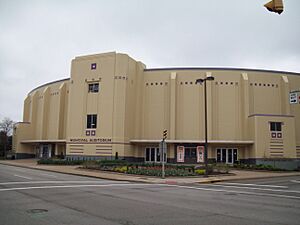
Charleston hosts many fun events and festivals throughout the year.
The West Virginia Dance Festival happens in late April. Dance students from all over the state come to take classes. They also perform for the public.
Symphony Sunday is usually held in early June. It's a day of music, food, and family fun. It ends with a free performance by the West Virginia Symphony Orchestra and fireworks.
The NPR show Mountain Stage started in Charleston in 1983. This live music program is recorded at the Culture Center Theater. It is heard across the country and around the world.
The West Virginia International Film Festival takes place twice a year. It shows many different kinds of films, including movies from other countries.
Charleston also hosts the annual Gazette-Mail Kanawha County Majorette and Band Festival. This festival started in 1947 and features high school bands.
On Memorial Day weekend, the Vandalia Gathering is held. Visitors enjoy traditional music, art, dance, and crafts from West Virginia's mountain culture.
Since 2005, FestivALL has brought many cultural and artistic events to Charleston. It includes dance, theater, and music performances. There's also an art fair and a wine and jazz festival.
The Charleston Sternwheel Regatta is a yearly river festival. It takes place on the Kanawha River. It has carnival rides, attractions, and live music.
Historic Buildings and Museums
Charleston has many old buildings with different architectural styles. About 50 places in Charleston are listed on the National Register of Historic Places. A part of the East End neighborhood is a historic district. It has many houses from the late 1800s and early 1900s.
Downtown Charleston has several historic commercial buildings. These include the Security Building and the Kanawha County Courthouse. There are also many historic churches close together in a neighborhood just east of downtown.
Other historic buildings include the West Virginia State Museum and the Capitol Theater.
Shopping in Charleston
The Charleston Town Center mall opened in 1983. It was once the largest downtown mall east of the Mississippi River. It has many shops and places to eat.
Charleston also has several large shopping areas. These include The Shops at Kanawha and Kanawha Landing in Kanawha City. There are also Southridge Centre, Dudley Farms Plaza, and The Shops at Trace Fork in the Southridge area.
Parks and Recreation
- University of Charleston Stadium at Laidley Field — Used for football, soccer, and other events.
- GoMart Ballpark — Home of the Charleston Dirty Birds baseball team.
- Cato Park — Charleston's biggest park, with a golf course and swimming pool.
- Coonskin Park — Has a swimming pool, tennis courts, and a golf course.
- Daniel Boone Park — A park with a boat ramp and picnic areas.
- Kanawha State Forest — A large forest with campsites.
- Magic Island — An area where the Elk River and Kanawha River meet.
- Haddad Riverfront Park
Sports Teams
| Club | Sport | Founded | League | Venue |
|---|---|---|---|---|
| Charleston Dirty Birds | Baseball | 2005 | Atlantic League of Professional Baseball (Independent) | GoMart Ballpark |
| West Virginia United | Soccer | 2003 | USL League Two | Schoenbaum Stadium |
| West Virginia Wildfire | Women's American football | 2008 | Women's Spring Football League | TBA |
The West Virginia United is a soccer team. They play their home games at Schoenbaum Stadium in Charleston.
Education in Charleston
Schools for Kids
Charleston has many schools that are part of Kanawha County Schools. There are three main high schools:
- Capital High School
- George Washington High School
- Charleston Catholic High School (a Catholic school)
Colleges and Universities
Charleston has a campus of West Virginia University. This campus is used for medical and dental students to complete their clinical training.
The University of Charleston is a private college located along the Kanawha River.
Nearby, you can find West Virginia State University in Institute. Also, BridgeValley Community and Technical College and Marshall University have campuses in South Charleston.
Media in Charleston
Charleston's main newspaper is the Charleston Gazette-Mail. The city also has many radio stations and television channels.
Getting Around Charleston
By Air
Yeager Airport is the biggest airport in West Virginia. It serves many passengers. It is also home to the McLaughlin Air National Guard Base.
By Train
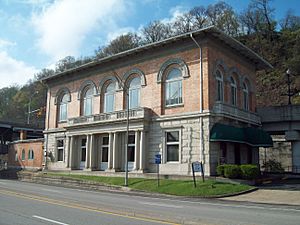
Amtrak, the national passenger train service, offers train rides to Charleston three times a week. The Amtrak station is located near downtown.
By River
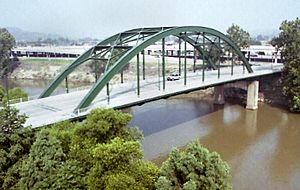
The Elk River flows into the Kanawha River in downtown Charleston.
By Road

Charleston is served by major highways like Interstate 64, Interstate 77, and Interstate 79. The West Virginia Turnpike also ends in the city.
Public Transportation
The Kanawha Valley Regional Transportation Authority provides bus services in Charleston.
City Services
Utilities
Appalachian Power provides electricity in Charleston. Suddenlink Communications offers cable TV. Frontier Communications provides landline phone service. West Virginia American Water supplies the city's water, which comes from the Elk River. Natural gas is supplied by Mountaineer Gas.
Police and Healthcare
The Charleston Police Department is the largest city police department in West Virginia.
CAMC is a group of hospitals in the city. Thomas Health also has hospitals and healthcare centers in the area. Highland Hospital focuses on behavioral health.
Famous People from Charleston
- Diplomat and attorney Harriet C. Babbitt
- Olympic shot put medalist Randy Barnes
- MMA fighter Brian Bowles
- Actress Jean Carson
- Cisco Systems CEO John Chambers
- Classical composer George Crumb
- Actress Jennifer Garner
- Civil rights activist Elizabeth Harden Gilmore
- Professional basketball player Alexis Hornbuckle
- Basketball player and broadcaster Hot Rod Hundley
- Soap opera actress Lesli Kay
- NBA player and coach George King
- Special effects artist Robert "RJ" Haddy
- Actress Allison Hayes
- Actress Ann Magnuson
- NASA astronaut Jon McBride
- Actor Tom McBride
- Psychologist George Armitage Miller
- Pop singer Caroline Peyton
- World's Strongest Man (2006) Phil Pfister
- Author Eugenia Price
- Comedian Roger Price
- Author and analyst Alec Ross
- Actress Kristen Ruhlin
- Country singer Red Sovine
- Civil rights activist Rev. Leon Sullivan
- NFL player and general manager Russ Thomas
- Actor Sam Trammell
- Tennis player Anne White
- NBA player Jason Williams
- Politician Daniel Webster
- Athlete and coach Harry Young
- Former NFL player Dennis Harrah
Sister City
Charleston has one sister city:
 Banská Bystrica, Slovakia (2009)
Banská Bystrica, Slovakia (2009)
See also
 In Spanish: Charleston (Virginia Occidental) para niños
In Spanish: Charleston (Virginia Occidental) para niños


